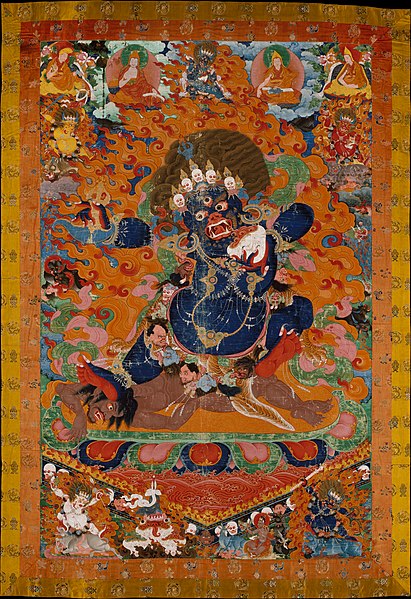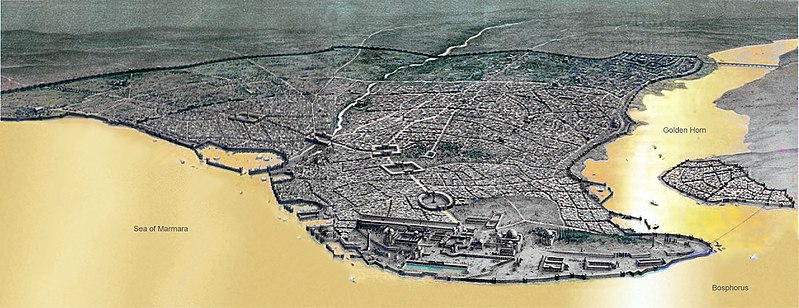1. To tackle the big one first, Leckie uses the personal pronoun “she” throughout to refer to everybody. This makes sense in context though, because the main character is mentally genderless and exists in a culture that is mentally genderless and uses a genderless language. The main character is a piece of a ship’s AI, an “ancillary”, so it is genderless. In the culture, gender roles and traits, such as long hair or makeup, are entirely mixed up and the language reflects this by being genderless. So, instead of using “it” and “they” throughout, Leckie uses “she”. I think this actually works: Leckie probably should use “she” or “he” in order to retain the personality and relatability of the characters, but she also uses it to communicate the humanity of the main character, who goes by Berq through the last two-thirds of the novel. However, if she is trying to make a point about gender identity in our culture, I think it’s slightly unsuccessful. Yes, it is jarring to hear a character use “he” in dialog, and I assume this is Leckie’s way to point out how jarring it is to read “she” in a novel of predominantly male characters. But those readers who would understand her gender-writing argument and give it a good thinking over, I think these readers are likely already there with her, and this novel probably won’t convince anybody new. This tactic is strange and unfamiliar, as a reader, but it works well to illuminate the unusual genderless nature of the culture. Without this, the strangeness of this specific genderless culture would've been much harder to communicate. So for me this tactic works, but not necessarily as a critique of our gendered language today.
2. Outside of this personal pronoun tactic, which helps build the world, the rest of the worldbuilding is strong. She introduces technology and organizational concepts through name-dropping, leaving specifics as mysteries, before explaining them later when it becomes beneficial to the story to do so. Rather than intro-info-dumping, she uses a noun to name a technology, than uses the explanation later to describe its effect on the story or characters. This is long-term world-building: it comes off like she has this planned out from the start. For instance: the title, Ancillary Justice. Both words in the title exhibit this tactic. The main character is an ancillary of a Justice, a troop-carrying class of starship. Within the first two chapters, these two words are fully explained, but not in an info-dump such as, “Ancillaries are physical representations, parts of a ship’s AI embodied in a human body that are capable of acting outside of the ship to great distances.” Rather, the first chapter explains this through showing instead of telling, and Leckie does it very well. She only shows how the technology affects the world, characters, and plot, keeping away from made up back story or discussing unimportant aspects of the technologies. She uses this noun-first, deferred explanation tactic throughout to explain most of the technologies and aspects of the world that contribute to building the reader’s conception of this culture and world. Her technique successfully illuminates the world, even though it doesn't give the reader all of the information about all of the technologies: certain things are left mysterious and not fully explained.
3. The writing itself is solid. There are some beautiful sounds in here, but it’s more her efficiency that astounds me. She manages to say so much through her evocative word choices. This isn’t an eight-grader’s vocabulary mated to standard sentence structures that repeat themselves. Various words and sentence structures keep the reading interesting. Here is a passage that I found beautiful:
“I had no information about her internal state. She seemed calm. Impassive, emotionless. I was sure that surface impression was a lie, though I didn’t understand why I thought that.”This is efficient and beautiful prose that does well by being wrinkled with world-building import. For instance, the point-of-view character in the example above can read any internal physical data for some of the characters, but feels unsure of itself when this information is unavailable—like in the sentences quoted. The vocabulary is above an eight-grader, but not obscure, not too far into the thesaurus. It’s a quality, fun read.
4. The structure of the story effectively pulls the reader along while simultaneously communicating the backstory and history of the world. The structure starts at a point we’ll call now. The next chapter begins about twenty years in the past. The chapters then alternate from now to past to now to past for two-thirds of the book before the past storyline is completed and only continued through the now taking over the novel and driving towards the end of the story. This allows Leckie to focus on important moments of the past without needing to be linear in the past—it allows Leckie to skip large spans of time in order to focus on important points, allows her to bridge gaps in the past or now narratives where nothing important happens, keeps the novel from needing filler. She also skips a good eighteen years or so of the past narrative because it doesn’t matter to the story: we understand what happened between nineteen years ago and now because of what now is like. The chapter breaks effectively fracture the twin narratives, letting her focus on important parts instead of worrying about every scene change. It’s a good structure for this story and Leckie deals with it deftly. Outside of this, when the Justice's AI is whole, she shatters the narrative between different viewpoints of the Justice in a way that at least equals the skill of the third chapter of Alduous Huxley's Brave New World. Leckie jumps from point-of-view to point-of-view in an interesting, confident way that illuminates the character of the Justice's AI, all while retaining legibility well. She is a strong storyteller.
5. Leckie uses the structure described above to pace the story perfectly. Each chapter begins on a slower note and builds action through to the end—sort of. Chapters generally have two major action points, with two portions of rumination—sometimes taking place in the middle of an action phase. This allows each chapter to be fairly self-contained and Leckie rarely relies upon cliff-hanger chapter endings to drive the reader to keep reading. Instead, her chapter structures and consistent chapter length allow the story to be told in a slow, self-contained way that reflects the way the main character would think through the story, conscious of its mental limitations as an ancillary, a part of itself, not a whole being, but a mere single human, and not even that.
6. One fault is that the novel, like so many other speculative fiction novels, begins with an apparent murder. Yes, she subverts this typical tactic, but it’s still an annoyance in the first line:
“The body lay naked and facedown, a deathly gray, spatters of blood staining the snow around it.”So many speculative fiction stories do this—start with a murder or rely upon violence to change the characters or progress the plot—that it gets tiresome as a reader. A little more variety would be nice. Here though, like in China Mieville’s The City and the City, it works. It works here because it’s a familiar reference point to start the story at—something recognizable before the world building brings the strangeness in; because it’s used skillfully—even though I don’t yet care about the characters, world, or writing, this situation allows the main character to be introduced sympathetically; and because Berq’s response to this body is an important aspect of her character that continues to be important throughout the novel—like in Mieville’s novel, the body is not forgotten, it exists in a context, and it grows in importance and complexity throughout the novel. So this opening murder works because Leckie has thought through it and uses it in an interesting way rather than as a cheap writer's trick. But it’s still initially annoying.
7. Leckie has obviously thought deeply about this world. For instance, one of her ideas is that ship and station AIs are programmed with emotions in order to prioritize data, experiences, and commands. This allows negatives—there are legends of ships going insane with grief when their captain dies—but also positives in that the ships more inherently understand their human crews and captains because they can understand their emotions intuitively. This example shows that Leckie has thought deeply about the issues inherent in earlier AI stories within science fiction. She has realized that the emotionless AI is problematic through misunderstanding the humans who work with it—when working together, communication and understanding are key, and many tensions in earlier science fiction stories arise from this lack of basic understanding of emotional context. Here she takes science fiction forward. Like so many others, she's using AI characters as centers of tension in the novel. But Leckie's doing it in a way that is distinctly her own. And most of the ideas in the novel are deeply thought through like this.
8. Leckie’s deep thinking about what other authors have done in the field shows a characteristic of her writing that some readers appear to have disliked: this is space opera. Some people are annoyed with some of the tropes and tactics that space opera typically engages, and they were annoyed by this novel. I was not. My bias is that I think all genres of music are interesting and I’m happy to listen to “Little High Plains Town” by Ian Tyson right after “Alfadanz” by Burzum—because they are both quality songs despite their widely different genres. I'm the same with writing. So the fact that a novel is space opera doesn’t annoy me unless it’s bad space opera, unless it is being used by the tropes and characteristics as some sort of catharsis for the author’s personal wish fulfillment. To me, this novel is good space opera. Leckie isn’t indulging here. She’s thinking deeply and modifying characteristics and tropes to inform the reader about the characters and world. The example above about emotional AI proves that Leckie is using the tropes and traits, but she's expanding them, modifying them, not being used by them or using them thoughtlessly. She’s writing in a way that makes sense to her story and characters here, and some of it seems to fall near some tropes. And that’s fine by me because she’s doing her own thing with them, expanding and changing them, not re-doing what other authors have done. However, it could be a bit baffling to non-science fiction fans because it is drawing from other texts. But I don’t think it’s possible the novel is entirely baffling to a new science fiction fan. I think a new science fiction reader would need to put in more effort than an old-hand, but it’s still legible and effective.
9. If you can’t yet tell, I think this book successfully tells an interesting story. Leckie writes well, structures the story well, consistently paces the novel, and deeply thinks about interesting ideas. I really appreciate the craft and care and thought she put into writing and structuring the story and characters. I cannot overstate how refreshing it is to read a well-written speculative fiction novel. Her training and study at a writing school shows here. This would've been a New York Times best seller if it didn't draw so heavily from the history of science fiction. This is confident, good writing and storytelling. She knows what she’s doing. She focuses on the characters, yet the overarching plot and world lives up to the strength of characterization throughout. With my past university studies into literature, this good writing breathes freshness into speculative fiction, reinvigorates my love for what a well-done speculative fiction novel can do when it really is novel. This leaves me applauding the writer, appreciating her craft, and pondering the ideas she presents believably in the text. This debut novel strengthens science fiction.
[Added 10/26/15: 10. The theme here is "what is human?" At the end, an AI in a human body gains some of the trappings of humans by gaining a surname. But really, this questions is shot through the whole book.]














.jpg/640px-Alpha%2C_Beta_and_Proxima_Centauri_(1).jpg)


























.jpg/800px-Dancing_(8517245863).jpg)



.jpg)


.jpg)